- May 10, 2019
- Posted by: admin
- Category: Latest News, Occasional Papers
Institutional and Sustainable Development Foundation
Research by: Ogwu Paul Okwuchukwu
Edited by: Ogwu Paul Okwuchukwu
© May 2019

OVERVIEW OF THE NIGERIAN EDUCATION SECTOR
- Introduction
- Background
- Policy Initiatives
- Composite Analysis
- Basic education: Low enrolment and low-quality teachers
- Secondary education: students’ poor performance records
- Universities: some specifics on the decline
- Challenges to the Educational Sector
- Remedies or recommendation on how to improve our education.
- TVE
- Agencies under the Ministries of Education
- Conclusion
OVERVIEW OF THE NIGERIAN EDUCATION SECTOR
1.1 Introduction
The Nigeria educational system is in the concurrent list in the Nigeria constitution. In the constitutional provisions, the main responsibilities of the Federal government in basic education are in the realm of policy formulation, coordination and monitoring. The Federal government controls a sizable number of the tertiary institutions and a handful of institutions at the secondary level (the Unity Schools and technical colleges). The bulk of secondary schools in the country are under the control of state governments, which are also directly responsible for a considerable proportion of the nation’s tertiary institutions- State Universities, Polytechnics and Colleges of Education. Local governments have statutory managerial responsibility for primary education, with the federal and state governments exercising appropriate oversight functions. There are also many Private schools and universities in the country controlled by private individuals, faith-based organisation and trust but are controlled by some specialised government agencies and institutions. There is a growing number of these private schools throughout the country. Although the number of schools is increasing it is not proportionate to the growing population. Nigeria has a low literacy rate and also an unproportionate number of out of school children.
This occasional policy paper shall be looking at the educational sector in general as it relates to the different segments of the educational sector in relation to human development. The analysis would be on the education segment as it relates to the contributions and challenges to different segments that impact on the economic, social and political development of the country. The analysis would look at early childhood education, primary education, secondary education, vocational and technical education and tertiary education. In our next publication, we would be looking at Almajiri and Qur’ anic, informal education, teacher’s education
As a vital path of any countries economic well-being, the educational sector deserves some greater attention not only because of the social, economic and political impact of the sector but also because of the role of education in human life. Nigerian educational system appears to be in shambles in all facets.
1.2 Background
The Nigerian education system has witnessed some changes and transformations. Some of the factors that have influenced the development and advancement of the Nigeria educational system includes; historical, Sociological factors, economic factor, political factor, geographical factor and international influences. All these contributed to some positive and others negative ways of shaping the current state of our educational sector. An analysis of these factors would show how vital education is and how factors that look unrelated affects the educational sector of the country. Our educational system has all the worst indexes compared to our mates and contemporaries in the world. The number of Nigeria studying in virtually all parts of the world is huge. The amount individuals spend in sending the children and relatives all over the world runs into millions of dollars.
2.1 Policy Initiatives
The Nigeria education falls in the concurrent list in the 1999 constitution. The sole aim of formulating the policy on education falls with the federal ministry of education as directed by the federal government. The Nigeria educational sector is guided by the National policy on education as published in 1977 and revised in 1981, 1990 and 2004, 2007 and. The Federal Ministry of Education is the policy-making arm of the government with the responsibility to supervise the educational sector of the country. The ministry whose vision statement is ‘to become an economy model, delivering sound education for public goods and a mission ‘to use education as a tool for fostering development of all Nigeria citizens to the full potential in the promotion of strong, democratic, egalitarian, prosperous, indivisible and indissoluble sovereign nation under God’ is one of the biggest and most important sectors of the economy.
The mandate of the ministry includes:
- Formulate and Coordinate national policy on Education
- To Collect and collate data for the purpose of educational planning and financing.
- Prescribe and maintain a uniform standard of Education throughout the country.
- Control and monitor the quality of Education in the country.
- Harmonize educational policies and procedures of all the states of the federation through the instrumentality of the national council on education.
- Effective co-operation in educational matters on an international scale.
- Develop curricula and syllable at the national level.
Some of the policy initiatives of the ministry towards achieving this goal include:
- Institutionalized autonomy of the Universities.
- The liberalization and private sector involvement in the setting up and running of schools.
- The introduction of the national Virtual library projects.
- Improved access to open universities and ODL.open and distance learning
- The development of National Vocational Qualification framework
- The intervention of some specialised agencies that have improved funding like TEFUND.
- The UBEC harmonisation of the alamijiri and quranic education with the rest of formal education.
3.1 Composite and other Analysis
The Nigeria education sector has grown astronomically in terms of the number of institutions and colleges scattered all over the country. Although this is not proportionate to the growth of the population, it shows some marginal improvement in terms of the number of enrolment and output. This is shown in the number of people that apply for the few available university spaces in the country of these numbers the available space for new intake may not take up to 10% of the students. This leaves a sizable gap to fill. The government through some reforms and liberation is trying to bridge the gap. Unlike before 1965 where they were only 4 first generation universities, the government has increased the number of universities to 122 with the federal government having 37 universities, the state government 38 universities and the private organisation and individuals controlling 79 universities. Also, there are many other people applying for the award of certificates to commence their university operations.
In the pre-nursery school and crèche the government is trying to formally normalise and regulate its operations.This very important sector was left in the hands of private individuals without adequate regulations and funding.These have come with several cases of abuse in the sector. This sector of the educational system is important because it lays the foundation for the students admitted in the primary schools and also helps the kids in improving their learning culture.

As a result of the previous educational policy in Nigeria which is 6334 system of education, this important segment was not recognized. The government in its recent reform adopted the 9-3-4 system of education. This is in recognition of the international standard as designed by education for all. Nigeria as a country did not only lag behind in realizing the MDG goal but it is also lagging behind currently in the SDG goals. It also has the highest out of school children in the world. It is estimated that 13.5 million Nigeria children are out of school- the population of lots of countries within and outside Africa. This leaves a sizable segment of the population out of school with the attendant social economic effect now and most especially in the future. This abysmal performance is a sore point in not only the attainment of our economic potential but has an enormous effect in the future. This is equally compounded with the inadequacies and shortfalls in girl education and the high percentage of dropouts. The state of the Nigeria education system is worse in the Northeast of the country and that may explain the high rate of people willing to join Boko Haram and high incidence of poverty. Although most other sections of the country have their own particular problem in the Educational sector some are still better intense literacy rate. As pointed out earlier, some factors seem to be mitigating the attendant education backwardness. For a repeat of the factors, It was stated that the following factor contributes to the state of our educational crisis. Historical, Sociological factor, economic factor, political factor, geographical factor and international influences. The historical factors explain why some people are better represented in the formal education sector because of their early encounter with the missionaries. sociological factor also shows the role of socialization towards education advancement especially the influence of culture, religion in educational development as it relates to the North. The northern part of the country is lagging behind the South because of some of these factors. The school enrollment in the north is poor so also the girl children education. This is as a result of cultural and religious factors. The Nigeria primary school has a funding and regulatory mix among the three tiers of government. The secondary school in Nigeria although the state government has almost an absolute control of the secondary school the federal government still run her unity school in all the states of the federation including the FCT. The state of the secondary schools in Nigeria also shows a countries lack of commitment in education especially the dilapidated and poor infrastructure, poorly and unqualified teachers and lack of basic equipment.

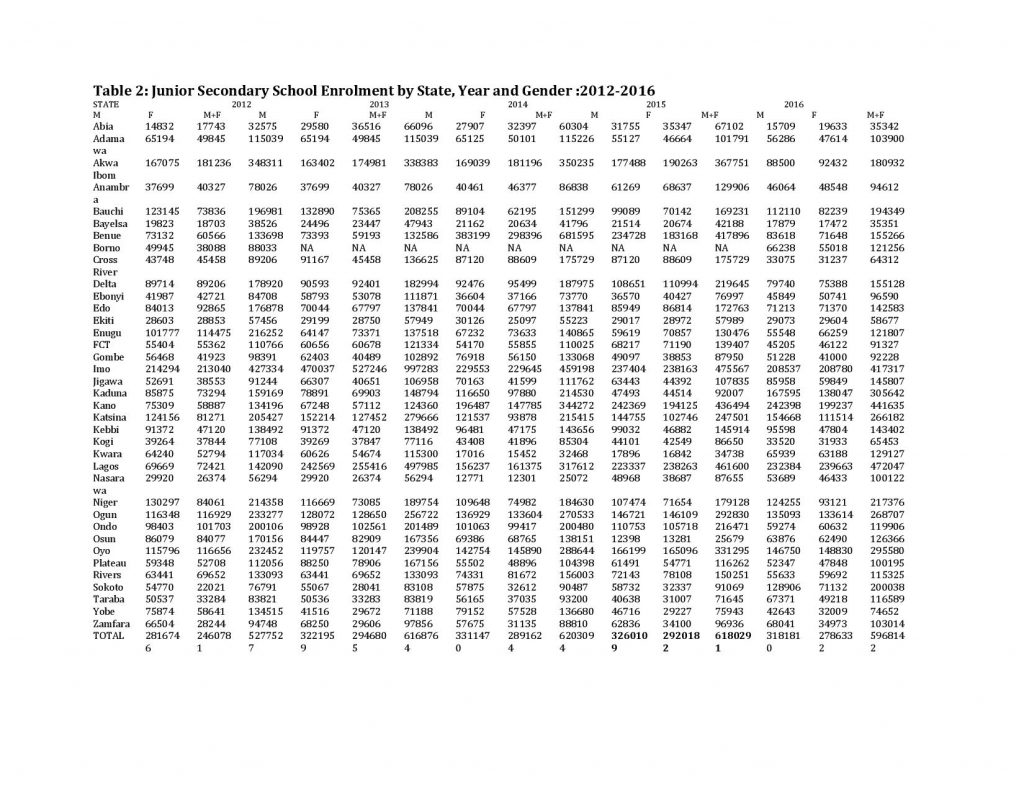
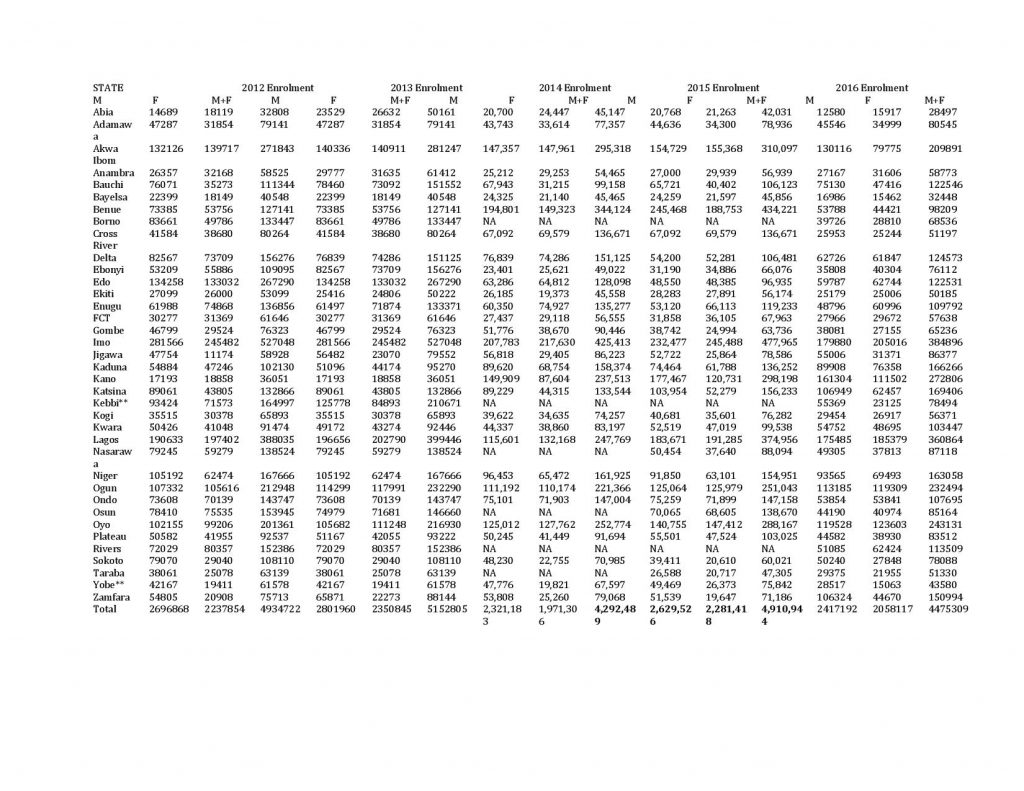 The table above shows the level of enrollment of both the primary and secondary school levels across the states. We will in our subsequent publications try to analysis the trends across the states and geopolitical zones. We will also show the role that culture, religion and other development indexes have affected school enrollment and attendance.
The table above shows the level of enrollment of both the primary and secondary school levels across the states. We will in our subsequent publications try to analysis the trends across the states and geopolitical zones. We will also show the role that culture, religion and other development indexes have affected school enrollment and attendance.
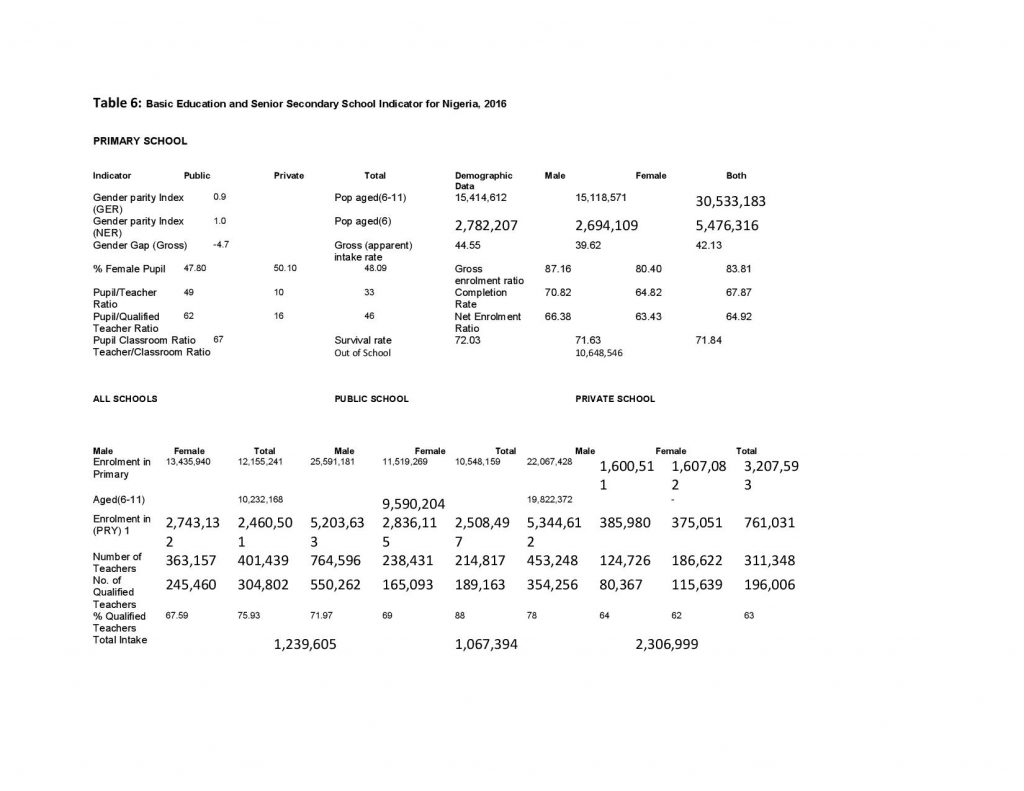
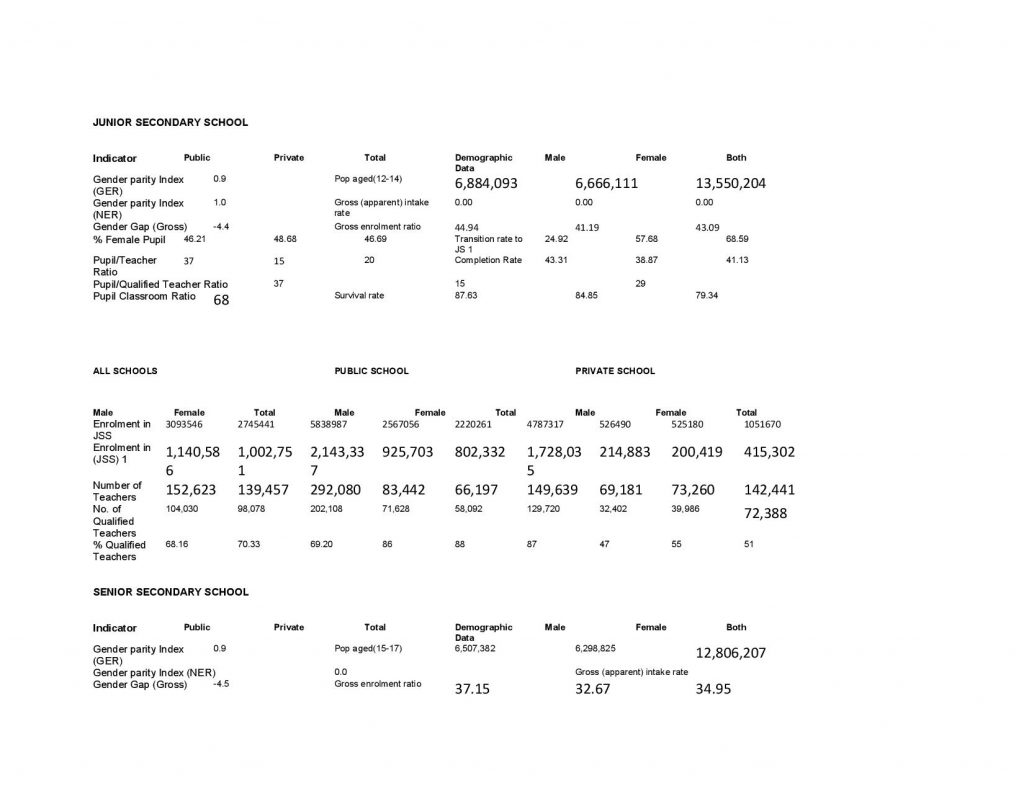
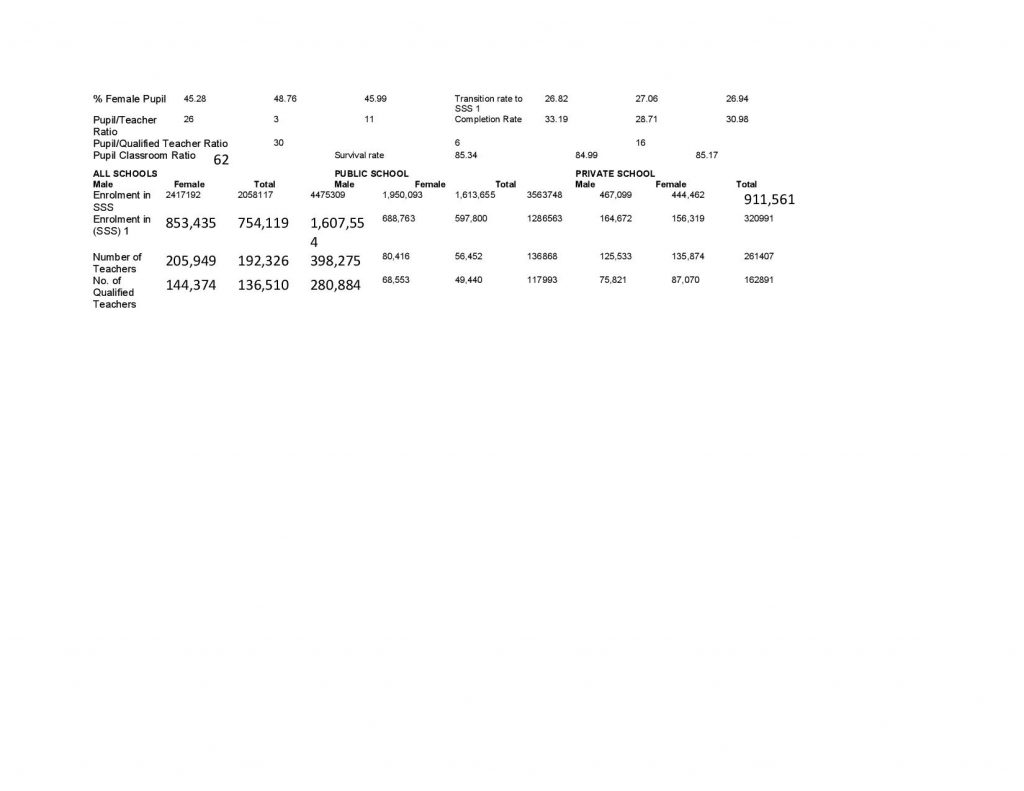
These, in summary, show the breakdown and analysis of the educational sector in Nigeria. With these segregation and breakdown analysis of the education sector.
Technical and Vocational Education
Technical and vocational education is one of the easiest ways to get away from poverty and improve your skill. In addition to achieving the following sustainable development goals: goal 4, goal 5, goal 8, goal 9 and goal 10. These include (1). end poverty in all its forms everywhere (2). promote sustained, inclusive and sustainable economic growth (3). full and productive employment and decent work for all (5). reduce inequality within and among countries, ensure inclusive and equitable quality education and promote lifelong learning opportunities for all will be achieved with effective and efficient TVET. All these SDG, s and the main thrust of our education policies and regulatory framework in Nigeria will go a long way in assisting the human development of the society and the country. TVET is a planned program of courses and learning, experiences that begin with the exploration of career options, supports basic academic and life skills and enables achievement of high academic standards, leadership, preparation for industry-defined work, and advanced and continuing education. The mandate of TVET is to provide individuals with learning experiences and training that equip them with skills to manipulate their natural environment and nurture development for their immediate community and the nation in general.
Unfortunately, education on technical and vocational training for skills acquisition suffers the most neglect. The sector is underfunded, the basic infrastructure needed to facilitate teaching and training is lacking virtually in all institutions offering programs in technology and vocational education. There are lack of workshop, rooms, and where they exist, the machine, equipment and facilities therein are in most number obsolete and in some cases housed in dilapidated building, the prevailing curriculum on TVET is old and without current issues and trends, there is acute shortage of experienced technology instructors in the country and most of the few available do not possess the necessary skills for practical activities, there is neither retraining scheme to keep teachers of technology abreast of the rapidly changing labour market nor do institutions offering technology education conduct production-based activities where TVET teachers could undertake their practical orientation on research and development.

The National Universities Commission (NUC), Nigeria presently has 43 Federal Universities, 48 State Universities, and 79 Private Universities. Remember that the NUC is the Agency tasked by the Nigerian Federal Government to regulate and act as a catalyst for positive change and innovation for the delivery of quality university education in Nigeria. https://campusbiz.com.ng/list-of-universities-in-nigeria/ | Campusbiz Journal
Nigerian Universities: Facts & Figures by ASUU Chairman Adebayo Oni.
- Less than 10% of the universities have Video Conferencing facility.
- Less than 20% of the universities use Interactive Boards
- More than 50% don’t use Public Address System in their lecture OVERCROWDED rooms/theatres.
- Internet Services are non-existent, or epileptic and slow IN 99% of Nigerian Universities
- Nigerian Universities Library resources are outdated and manually operated. Bookshelves are homes to rats/cockroaches
- No university library in Nigeria is fully automated. Less than 35% are partially automated.
- 701 Development projects in Nigerian universities 163 (23.3%) are abandoned 538 (76.7%) are PERPETUALLY on-going projects.
- Some of the abandoned projects in Nigerian universities are over 15 years old, some are over 40 years old.
- 76% of Nigerian universities use well as a source of water, 45% use pit latrine, 67% of students use the bush as a toilet.
- UNN and UDUS have the highest number of abandoned projects (22 and 16 respectively).
- All NDDC projects across universities in the Niger Delta States are abandoned. About 84.6% of them are students’ hostels
- 77% of Nigerian universities can be classified as “Glorified Primary Schools” Laboratories are not existing
- There are 8 on-going projects at the Nasarawa State University, Keffi. None of them is funded by the State Government
- 80% of Nigerian Universities are grossly under-staffed
- 78% of Nigerian Universities rely heavily on part-time and visiting lecturers.
- 88% of Nigerian Universities have under-qualified Academics
- 90% of Nigerian Universities are bottom-heavy (with junior lecturers forming a large chunk of the workforce)
- Only 2% of Nigerian Universities attract expatriate lecturers, over 80% of Ghanian Universities attract same.
- 89% of Nigerian Universities have ‘closed’ (homogeneous staff – in terms of ethno-cultural background)
- Based on the available data, there are 37,504 Academics in Nigerian Public Universities
- 83% of the lecturers in Nigerian universities are male while 17% are female.
- 23,030 (61.0%) of the lecturers are employed in Federal universities while 14,474 (39.0%) teach in State Universities.
- The teaching staff-students ratio is EMBARRASSINGLY very high in many universities:
- LECTURER STUDENT RATIO: National Open University of Nigeria 1:363 University of Abuja 1:122 Lagos State University 1:111
- (Compare the above with Harvard 1:4; MIT 1:9; Yale 1:4, Cambridge 1:3; NUS 1:12; KFUPM 1:9; Technion 1:15).
- Nigerian Universities Instead of having 100% of Academics having PhDs, only about 43% do so. The remaining 57% have no PhDs
- Nigerian University medical students trained in the most dangerous environment, some only see medical tools in books,
- Only 7 Nigerian Universities have up to 60% of their teaching staff with PhD qualifications. 29. While the majority of the universities in the country are grossly understaffed, a few cases present a pathetic picture.
- There are universities in Nigeria which the total number of Professors is not more than Five(5)
- Kano University of Science and Technology Wudil, established in 2001 (11 years old) only 1 Professor and 25 PhD holders.
- Ondo State University of Sci & Tech Okitipupa, established in 2008, has a total of 29 lecturers.
- MAKE-SHIFT LECTURING SYSTEM: Out of a total of 37,504 lecturers, only 28,128 (75%) are engaged on a full-time basis.
- 9,376 (25%) Nigerian Lecturers are recycled as Visiting, Adjunct, Sabbatical & Contract lecturers.
- In Gombe State University, only 4 out of 47 Profs are full-time & all 25 Readers are visiting 37. In Plateau State University, Bokkos, 74% of the lecturers are visiting.
- In Kaduna State University, only 24 out of 174 PhD holders are full-time staff.
- 700 EX-MILITANTS in Nigeria are receiving more funds annually than 20 Nigerian universities under ‘Amnesty Scam’
- 80% of published journals by Nigerian University lectures have no visibility in the international knowledge community.
- No Nigerian academic is in d league of Nobel Laureates or a nominee of Nobel Prize.
- There are only 2 registered patents owned by Nigerian Academics in the last 3 years.
- Numerically more support staff in the services of Nigerian universities than the teaching staff they are meant to support
- More expenditure is incurred in administration & routine functions than in core academic matters in Nigerian Universities
- There are 77,511 full-time non-teaching staff in Nigeria’s public universities 2 Times number of academic staff
- UniBen, there are more senior staff in the Registrar cadre (Dep. Registrars, PARs, SARs) than Professors
- Almost all the universities are over-staffed with non- teaching staff
- There are 1,252,913 students in Nigerian Public Universities. 43% Female 57%Male
- There is no relationship between enrollment and the tangible manpower needs of Nigeria.
- Nigerian Uni Horrible hostel facilities, overcrowded, overstretched lavatory and laundry facilities, poor sanitation, etc
- Except for Nigerian Defence Acadamy Kaduna, no university in Nigeria is able to accommodate more than 35% of its students.
- Some universities (e.g. MOUAU), female students take their bath in d open because d bathrooms are in very poor condition.
- Laundries and common rooms in many universities have been converted into rooms where students live, in open prison style.
- In most improvised cage called hostels in Nigerian Universities, there is no limit to the number of occupants.
- Most State universities charge commercial rates for unfit and unsuitable hostel accommodation.
- In off-campus hostels, students are susceptible to extraneous influences and violence prostitution, rape, gang violence.
- Nigerian University Students sitting on bare floor or peeping through windows to attend lectures
- Over 1000 students being packed in lecture halls meant for less than 150 students
- Over 400 Nigerian University students being packed in a laboratory meant for 75 students
- Univ admin spend millions on super-gates when their Libraries are still at the foundation; millions on exotic cars for uni officers even though they lack basic classroom furnishings; millions in wall-fencing & in-fencing when students accommodation is inadequate & in tatters;
- Govt spends money on creating new unis instead of expanding access to existing ones; keen to award new contracts rather than complete abandoned projects or standardize existing facilities; expends millions on visiting & part-time lecturers rather than recruit full-time staff.
- Govt spending hundreds of millions in mundane administration cost instead of providing boreholes and power supplements; Govt hiring personal staff, including Personal Assistants, Special Advisers, Bodyguards, Personal Consultants, etc.
With the following statistics above we could see the state of the Nigeria universities.
Polytechnique and Colleges of Education
There are up to 126 Polytechnique for the federal, states and private Polytechnique and 85 colleges of education. The importance of these two educational sectors to the development of human capacity and industrial development of Nigeria cannot be overestimated. Polytechnics should serve as the springboard for the production of medium level and practical manpower for the advancement of technological advancement of the country.
For the colleges of education, the role and contribution of pedagogy to the overall educational development, standard and output. The pedagogy is one of the most determining factors towards human capital development that is capable of producing a workforce that will propel the country towards greatness. Unfortunately, both the Polytechnique and colleges of education have not taken up these vital function dues to some hinderances effecting the quality of education.
Major Agencies , Parastatals and Departments Under Education
- National Universities Commission (NUC), Abuja.
- National Board for Technical Education (NBTE), Kaduna.
- National Commission for Colleges of Education (NCCE), Abuja.
- Universal Basic Education Commission (UBEC), Abuja.
- National Commission for Nomadic Education, (NCNE), Abuja
- National Commission for Adult Education Mass Literacy and Non-Formal Education (NMEC), Abuja
- Nigerian Educational Research Development Council (NERDC), Sheda, FCT.
- Joint Admissions and Matriculation Board (JAMB), Bwari, Abuja.
- West African Examination Council (WAEC), Lagos.
- National Examination Council ( NECO), Minna
- National Business and Technical Examination Board (NABTEB).
- National Institute for Educational Planning & Administration (NIEPA), Ondo.
- National Teachers Institute (NTI), Kaduna.
- Nigerian Mathematical Centre (NMC), Sheda, FCT.
- Nigerian French Language Village (NFLV)Badagry, Lagos.
- Nigerian Arabic Language Village (NALV) Ngala, Borno.
- National Institute for Nigerian Languages (NINLAN) Aba, Abia.
- Tertiary Education Trust Fund (TET FUND), Abuja.
- National Library of (NLN), Abuja.
- Teachers’ Registration Council of Nigeria (TRCN), Abuja.
- Computer Professionals Registration Council of (CPN), Lagos.
- Federal Scholarship Board, Abuja
Remedies or recommendation on how to improve our education
- The need to improve and streamline on the oversight function and regulatory agencies to enhance good governance, standardization and reducing of other hindrances to the educational sector.
- A wholesome review of the curriculum and academic discipline to take care of the immediate needs of the community and domestication of needs of the citizenry.
- A need to consciously bridge the gender gap and review of acts, customs that encourage the limited involvement of women in Education and girl child education.
Finding ways of stimulating the girl child education. This bridging of the gender gaps should also look at the access, opportunity and responsibility
- Training and retraining of teachers, lecturers to ensure that understanding the modern teaching methods.
- The planning of expansion should be done systematically so that the quantity and quality of education will not be affected.
- The economic development of the country should be based on the development of human capital. This will improve economic development and ensure sustainable development.
4.1 The cause of the crisis in the Nigerian education sector
The cause of the crisis in the Nigerian education sector is widespread and systemic. This crisis has continued to affect the economic growth and development of Nigeria. Some of the causes of the crisis in terms of dwindling quality of education and the near collapse of the Nigeria educational system include.
- The lack of reliable data in the planning of sustainable education policy and programme. Like the countries, exact population and educational need are not well captured to be able to plan.
- The over-centralisation of power within the regulatory agencies and the lack of capacity to regulate effectively. Lack of implementation and implementation failures of some of the government policies and programmes in the educational sector. The overlapping function of the federal government and state government in the management and policy formulation as it relates to primary, secondary and university education.
- The depreciation and overstretching of the school infrastructures in the universities and other schools.
- Poor regulatory oversight in terms of ensuring the standardisation of the school curriculum across the board.
- The lack of or poor training and retraining of the teachers or other human resources that would have ensured the standard of the education.
- The issue of good governance and lack of transparency and accountability within the administration of the school.
- Social, political and economic factors also contribute to the decline of the education sector.
- The inability of the institutions that oversee education to effectively change the curriculum to reflect the current state of our country and economy.
- Lack of inadequate funding and effective utilisation of the funds available
5.1 Challenges to the Educational Sector
The education sector in Nigeria has some challenges. Whereas childhood education and primary education has some peculiar challenges, secondary and tertiary schools also face a unique challenge. Apart from the issues of finance which cut across all the segment of education, lack of qualified and competent teachers. The education sector in Nigeria faces some peculiar challenges that need to be addressed.
Challenges in the educational sector includes:
- Lack of available and reliable data. This lack of reliable data is affecting good planning and implementation of educational policies.
- Funding issues. The Nigeria educational sector suffers from lack of fund and where the fund is available mismanagement and misappropriation of the funds in question.
- Policy inconsistencies and lack of programme implementation especially in the cases of university autonomy
- The reduction in the value of education and recognition of intellect in the country.
- Inappropriate human resources in terms of teachers and experts.
- Over-centralisation of the power of the regulatory agencies thereby affecting the standardisation of education.
6.0 Conclusion
The Nigeria educational system is at a crossroad. Although a concentred effort is being to address the bad state of the educational sector, more effort should be put in place to redress long years of educational neglect by subsequent organisations. The poor educational standard is affecting virtually every sector of the country. Any nation that wishes to advance economically must take the issue of education very seriously. The social economic implication of a strong and viable educational sector, especially in this knowledge economy, cannot be over emphasis. The development of education is a sure way of ensuring the realisation of education not only as a right of the citizenry but also one of the most important aspects of human development.
References
http://www.nigeria.gov.ng/index.php/2016-04-06-08-40-29/executive/146-federal-ministry-of-education
Nigeria Educational System: Drift Needs Urgent Attention;http://www.gamji.com/article9000/NEWS9192.htm
https://campusbiz.com.ng/list-of-universities-in-nigeria/ | Campusbiz Journal
University in Nigeria (Federal, State and Private Universities), List of Universities in Nigeria approved by NUC, (2019 Latest List), by Bolaji Funmilola February 8, 2019
https://www.linkedin.com/pulse/role-technical-vocational-education-training-tvet-skill-paul-ogwu/
www.nemis.gov.ng/downloads_fold/Nigeria%20Education%20Indicators%202016.pdf
Adebayo Oni. President, Academic Staff Union of Universities on the Nigeria universities.
National Policy on Education 2008
